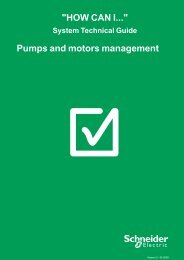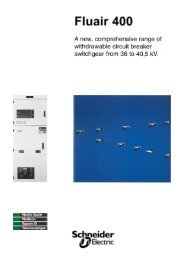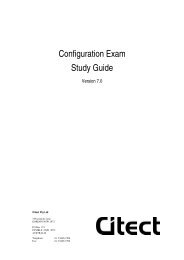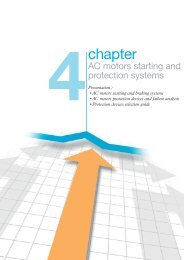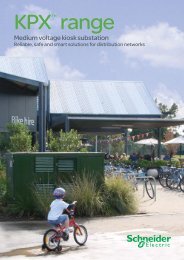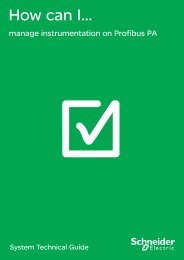Connect - Schneider Electric
Connect - Schneider Electric
Connect - Schneider Electric
You also want an ePaper? Increase the reach of your titles
YUMPU automatically turns print PDFs into web optimized ePapers that Google loves.
5 CONSOLIDATED FINANCIAL STATEMENTS<br />
NOTES TO THE CONSOLIDATED FINANCIAL STATEMENTS<br />
1.16 – Cash and cash equivalents<br />
Cash and cash equivalents presented in the balance sheet consist<br />
of cash, bank accounts, term deposits of three months or less and<br />
marketable securities traded on organized markets. Marketable<br />
securities are short-term, highly-liquid investments that are readily<br />
convertible to known amounts of cash at maturity. They notably<br />
consist of commercial paper, mutual funds and equivalents. In light of<br />
their nature and maturities, these instruments represent insignifi cant<br />
risk of changes in value and are treated as cash equivalents.<br />
1.17 – <strong>Schneider</strong> <strong>Electric</strong> SA shares<br />
<strong>Schneider</strong> <strong>Electric</strong> SA shares held by the parent company or by<br />
fully consolidated companies are measured at acquisition cost<br />
and deducted from equity. They are held at their acquisition cost<br />
until sold.<br />
Gains (losses) on the sale of own shares are added (deducted) from<br />
consolidated reserves, net of tax.<br />
1.18 – Pensions and other employee benefit<br />
obligations<br />
Depending on local practices and laws, the Group’s subsidiaries<br />
participate in pension, termination benefi t and other long-term<br />
benefi t plans. Benefi ts paid under these plans depend on such<br />
factors as seniority, compensation levels and payments into<br />
mandatory retirement programs.<br />
Defined contribution plans<br />
Payments made under defi ned contribution plans are recorded<br />
in the income statement, in the year of payment, and are in full<br />
settlement of the Group’s liability.<br />
In most countries, the Group participates in mandatory general<br />
plans, which are accounted for as defi ned contribution plans.<br />
Defined benefit plans<br />
Defi ned benefi t plans are measured using the projected unit<br />
credit method.<br />
Expenses recognised in the statement of income are split between<br />
operating income (for current service costs) and net fi nancial income/<br />
(loss) (for fi nancial costs and expected return on plan assets).<br />
The amount recognised in the balance sheet corresponds to the<br />
present value of the obligation, adjusted for unrecognised past<br />
service cost and net of plan assets.<br />
Where this is an asset, the recognised asset is limited to the present<br />
value of any economic benefi t due in the form of plan refunds or<br />
reductions in future plan contributions.<br />
Changes resulting from periodic adjustments to actuarial<br />
assumptions regarding general fi nancial and business conditions<br />
or demographics (i.e., changes in the discount rate, annual salary<br />
increases, return on plan assets, years of service, etc.) as well as<br />
164 2011 REGISTRATION DOCUMENT SCHNEIDER ELECTRIC<br />
experience adjustments are immediately recognised in the balance<br />
sheet and as a separate component of equity in “Other reserves”.<br />
Other commitments<br />
Provisions are funded and expenses recognised to cover the<br />
cost of providing health-care benefi ts for certain Group retirees in<br />
Europe and the United States. The accounting policies applied to<br />
these plans are similar to those used to account for defi ned benefi t<br />
pension plans.<br />
The Group also funds provisions for all its subsidiaries to cover<br />
seniority-related benefi ts (primarily long service awards in its French<br />
subsidiaries). Actuarial gains and losses on these benefi t obligations<br />
are fully recognised in profi t or loss.<br />
1.19 – Share-based payments<br />
The Group grants different types of share-based payments to senior<br />
executives and certain employees. These include:<br />
• <strong>Schneider</strong> <strong>Electric</strong> SA stock options;<br />
• stock grants;<br />
• stock appreciation rights, based on the <strong>Schneider</strong> <strong>Electric</strong> SA<br />
stock price.<br />
Only plans set up after November 7, 2002 that did not vest prior to<br />
January 1, 2005 are affected by the application of IFRS 2 – Sharebased<br />
payments.<br />
Pursuant to this standard, these plans are measured on the date<br />
of grant and an employee benefi ts expense is recognised on a<br />
straight-line basis over the vesting period, in general three or four<br />
years depending on the country in which it is granted.<br />
The Group uses the Cox, Ross, Rubinstein binomial model to<br />
measure these plans.<br />
For stock grants and stock options, this expense is offset in the<br />
own share reserve. In the case of stock appreciation rights, a liability<br />
is recorded corresponding to the amount of the benefi t granted,<br />
re- measured at each balance sheet date.<br />
As part of its commitment to employee share ownership, <strong>Schneider</strong><br />
<strong>Electric</strong> gave its employees the opportunity to purchase shares at a<br />
discount (note 21.5).<br />
1.20 – Provisions for contingencies and pension<br />
accruals<br />
A provision is recorded when the Group has an obligation to a third<br />
party prior to the balance sheet date, and where the loss or liability is<br />
likely and can be reliably measured. If the loss or liability is not likely<br />
and cannot be reliably estimated, but remains possible, the Group<br />
discloses it as a contingent liability. Provisions are calculated on a<br />
case-by-case or statistical basis and discounted when due in over a<br />
year. The discount rate used for long-term provisions was 3.42% at<br />
December 31, 2011 versus 2.75% at December 31, 2010.




